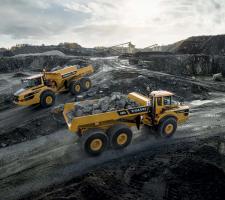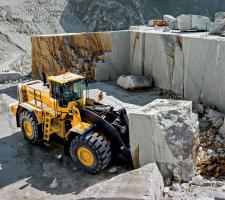
Eberhard Wedekind is a key member of Volvo Construction Equipment’s executive management team. Based at the company’s headquarters in Brussels, Belgium, Wedekind is drawing on his vast experience, including within the quarrying and mining sectors, to help steer the construction industry giant through the current tough trading climate. Guy Woodford went to meet him.
Anyone wanting to learn about the competitive nature of Eberhard Wedekind, Volvo Construction Equipment’s Executive Vice President (EVP) of sales, should take in one of his Saturday morning tennis matches at his local club in Brussels.
A highly promising player on the youth tennis circuit in his native Germany, Wedekind has since lost none of his passion for the sport. “I like the competitiveness - the spirit of one on one competition. There are a lot of technical and physical skills needed. You also need to have good tactics and read your opponent. I like the inter-club tournaments we play in Brussels, especially in the spring.
“I was watching the 2015 Wimbledon Final. Federer v Djokovic. It was an unbelievable fight. I read that Djokovic is practising six to seven hours a day. At that level, your entire psychology and physical being is challenged. Of all sports I’ve tried out, tennis has always been my favourite.”
You get the feeling while talking to Wedekind that he is used to winning. His determination to win on the tennis court is mirrored in his determination to achieve success in the various roles he has held within Volvo Construction Equipment (
The fallout of the 2008 global economic crisis is still depressing global construction equipment demand, with senior executives like Wedekind trying to find a way to achieve sales growth against what must, to use a tennis metaphor, feel like a relentless opponent armed with a big booming serve.
Despite being faced with such a formidable opponent, the Volvo CE sales and marketing chief, fluent in German, English, French and Italian, believes the company has everything in place for a bright future.
This is supported by the latest Volvo CE Q2 2015 trading revenues which rose by 5% to €1.656 billion (SEK 15,419 million), with profitability also up by an eye-catching 80%, compared to the same period of 2014, despite significant declines in major markets.
“Our executive management team is of the opinion that we need to be more focused on what is a profitable part of the business as the markets overall have been down in the last couple of years,” says Wedekind. “By reducing investment in the not so profitable parts of Volvo CE equipment range, more R&D resources can now go into the larger units – including earthmoving machines for the quarrying sector,” he explains.
“We are extremely happy with our Tier 4 Final/Stage IV engines in our machines, and the supporting service systems for them – such as the customer service agreement.
“Since I took my current role, we have made dealer development a much more strategic exercise. We follow much more closely how the dealers are developing. Are the dealers financially sound and stable? Are they investing sufficiently? Are they investing where needed in salesman, mechanics and workshops? We have increased our customer intimacy. They seem to be really appreciating how we are serving them in these tougher times.”
Volvo CE dealership network currently stretches across 130 countries, with all dealers able to benefit from the company’s ‘Partnership Development Programme’. “There are dealer operating standards, 70-80 key performance indicators and various targets set, depending on the customer mix. These targets differ for different market segments – such as for quarrying and mining customers. With these customers, dealers must have an almost consultant capability, to be potentially on-site helping them to understand what’s happening,” explains Wedekind. “For a mining customer, it could be that we suggest that instead of taking 10 articulated haulers and by optimising processes, one additional back-up machine might do the same job.
“There is a need for additional working capital and I’ve been talking to Volvo Financial Services about how we can best help quarry and mining customers. Customers are thinking by the hour, and instead of buying equipment, which goes on their balance sheet, they pay for the usage of the machine. This means that dealers have the skills to meet this demand. We have a site simulation tool for dealers that simulates what is happening on their customers’ sites.
“When I was in Asia we were developing some of these programmes and tools. Now we are rolling them out across the world.”
Wedekind pulls no punches about the state of some of the key global construction equipment sales markets. “The Chinese construction equipment market is down 72% versus 2011. When it comes to mining, it might even be a little bit more. I don’t think our industry has ever seen this before. The Russian market is down 72% this year versus last year. When you talk about Brazil, the market is 48% down.
“The only BRIC that is promising is India, with the new Prime Minister Narendra Modi in place. That market is expected to grow, particularly the demand for big equipment. The Middle East is also extremely strong in demand for heavy equipment for infrastructure projects. On South East Asia, in Indonesia we have a good market share, but demand with mining is dramatically down. Part of that is due to the government’s decision not to export minerals. The market there for ADTs was 1,000 a year just two years ago. Now it’s 250. This is the challenge for OEMs with emerging and BRIC markets. Many are government policy driven.”
Continuing his assessment of major international construction equipment sales markets, Wedekind says South African demand is down 12% but remains very much a market for backhoe loaders. “The rest of Africa follows the same trends, and the demand there is for the heavier machines, rather than the compact models,” he adds.
Turning his attention to the North American market, Wedekind says: “The North American market is stabilising at the high levels. North America has seen quite a dramatic shift from selling out of the box towards any kinds of rental, leasing or financing. But this doesn’t really change the industry, as it means rental companies and our dealers need to take the models on their books.”
Wedekind says that demand for heavier equipment is also high in Scandinavia. “I was in Kiruna, northern Sweden recently, where they have the biggest mines in Europe. It’s boom times there. They have an unbelievable 600km of asphalted underground roads. It’s huge.”
Growing demand for used equipment, demonstrated partly by the huge numbers taking part in both online and on-site auctions, also offers good sales opportunities for Volvo CE, believes Wedekind.
Of the company’s best-selling heavier machine models, he says Volvo CE’s largest articulated haulers are in “enormous demand” within quarrying and mining. “I was six years heading our Asian business, and the A40s were selling well there – especially for light mining. That’s still the case. On the excavator side, the 70tonne EC700 excavator is very popular, as is the EC460 and EC360. Our bigger wheeled loaders are also selling well.”
Crucially for Volvo CE’s quarrying and mining sector product offer, the completion of its €162 million (around SEK 1 billion) acquisition of
Of how he sees Volvo CE standing out from the increasingly stiff competition of other major international OEMs, Wedekind says: “We have always been pioneers when it comes to new engine and driveline technology. Our core values, quality, safety and environmental care are a commitment to meet the expectations of customers, business partners and society. The topic of environmental responsibility is increasingly important on customers’ agenda. And we are also very, very strong on heavy line innovation and product design. We have been winning Red Dot design awards. Our products are able to work in very tough conditions. We are also very strong and leading on fuel efficiency and can demonstrate benefits, such as increased uptime, productivity and serviceability, when it comes to total cost of ownership.
“We are particularly strong in our market share for middle to upper end size machine models. The technology needed to be on top in this area means there are not so many players.” Wedekind believes Volvo CE’s SDLG brand, which were not present in this range of equipment until the Volvo CE acquisition in 2007, offers promising growth potential in this part of the Asian construction equipment market.
Wedekind says Volvo CE’s R&D work on its heavy equipment lines continues to be focused on engine development. The company’s R&D engineers are also looking at hybrid technology, new machine control devices, and better harnessing of Volvo CE’s CareTrack telematics package for fleet management. Further work is also being done on a new Volvo CE site management solution.
Some of the R&D work on making Volvo CE machines “smarter” will, says Wedekind, be evident in a number of the Swedish company’s heavier and other models on display at bauma 2016 in Munich, the world’s biggest construction equipment exhibition.
The senior Volvo CE executive is keen to stress how Volvo CE’s spirit of innovation is demonstrated by its involvement within the Volvo Group’s environmental work - including the renewal of the Group’s ambitious commitment to reduce carbon dioxide emissions as part of the World Wide Fund for Nature’s Climate Savers programme.
Volvo CE was also recently awarded a €6.39 million (SEK 59 million) grant from the Swedish Energy Agency to develop new technology connected to electromobility that could transform the construction equipment industry.
Working collaboratively with Skanska Sweden, the Swedish Energy Agency and Swedish universities Linköpings universitet and Mälardalens högskola, the €22 million (SEK 203 million) project will see Volvo CE develop a range of customer and environmentally friendly solutions.
Our allotted hour is up and Wedekind says he needs to join a conference telephone call. No matter where his global role takes him during any given week, one thing is pretty much guaranteed – he’ll be back on his local Brussels tennis court come Saturday morning striving to win the game, set and match.











